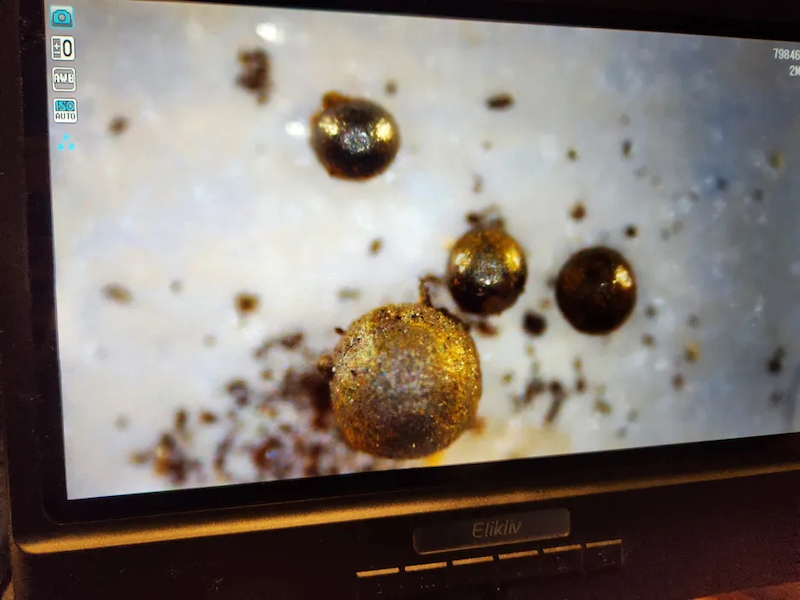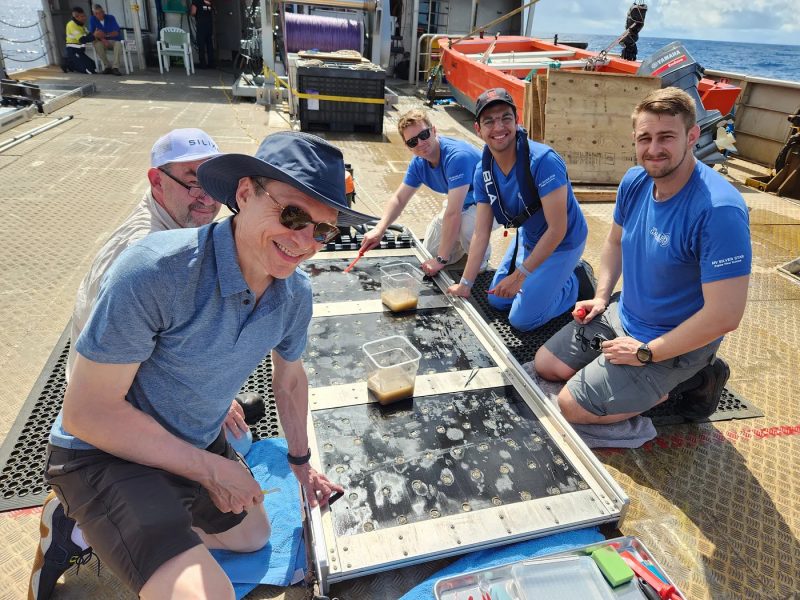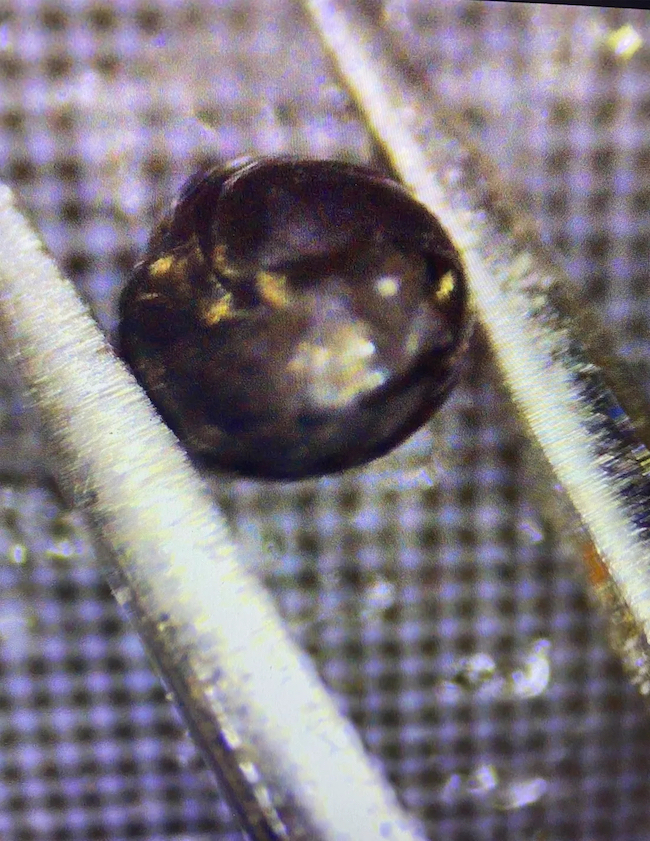
In 2014, an interstellar object – thought to be from another star system – streaked across Earth’s skies as a meteor, then crashed into the Pacific Ocean near Papua New Guinea. Harvard astronomer Avi Loeb is now leading a sea-going search, combing the ocean floor with what’s essentially a large magnet, hoping to pick up fragments of that object. He’s found bits of wire, tiny aluminum shards and volcanic ash. And this week (June 21, 2023), Loeb reported that his team has found tiny metallic spherules whose composition suggests an unearthly origin.
Loeb posted the news in his onboard diary, which is published at Medium. He included a photo of a few of the odd objects, which are minuscule, only about 0.3 mm (about one-hundredth of an inch) in size. And he added a couple of more photos in his latest post on June 22.
Becky Ferreira also wrote about the discovery for Vice on the same day.
Loeb likens the search to “finding a needle in the ocean.”
Avi Loeb wants to find alien fragments
Loeb and his team on an expedition vessel called the Silver Star. They’re looking for traces of what’s now called IM1, widely considered as the first known interstellar meteor.
That is, it was the first object from another star system known to strike Earth’s atmosphere and streak across our skies as a meteor.
Avi Loeb is widely known for his idea that some objects of interstellar origin might be artificial, made by alien civilizations. His 2021 book is titled Extraterrestrial: The First Sign of Intelligent Life Beyond Earth. It was a New York Times best seller. And Loeb has a second book on this subject, coming out later this year.
So IM1 – then known as CNEOS 2014-01-08 – crashed into the Pacific Ocean near Papua New Guinea on January 8, 2014. U.S. Department of Defense (DoD) sensors detected the meteor at the time.
Scientists studied the object’s path, prior to its striking Earth’s atmosphere. In this way, they identified it as being possibly interstellar, that is, as having come from another star system, in 2019.
In April 2022, the U.S. Space Command – which is responsible for military operations in outer space – confirmed in a memo that the meteorite that struck Earth in 2014 had indeed come here from another star system.
The search itself
Loeb’s search for the object’s remnants began on June 14, 2023. The team is using a deep-sea magnetic sled, dragging the sled across the ocean floor.
Loeb had worked previously to narrow down the path the meteor took over the ocean, to find a probable impact site. As he and Amir Siraj had explained in a draft paper from May 9, 2023:
We use data from a nearby seismometer to localize the fireball to a 16 square kilometer region within the 120 square kilometer zone allowed by the precision of the DoD-provided coordinates. The improved localization is of great importance for a forthcoming expedition to retrieve the meteor fragments.

What are the spherules?
So, what are these spherules? So far, the team has found 11 of the objects, embedded in the volcanic ash. They are tiny indeed, most about 0.3 millimeters (about one-hundredth of an inch) in diameter and some slightly smaller. The team is now looking for more of them. Loeb said:
It is difficult to identify visually or separate with tweezers spherules smaller than 0.25-millimeter, and so we are using a filter with this mesh size. Moreover, smaller spherules are swamped by the vast abundance of tiny particles in volcanic ash. There is, therefore, a sweet spot at around a size of 0.25 millimeter for finding metallic pearls that are visible in our microscope images, easy to handle with our tweezers, and are not as rare as their bigger counterparts.
Loeb estimates that the breakup of the meteor produced at least 10,000 spherules bigger than a quarter of a millimeter. He said:
Given that the meter-scale width of the sled is about a thousand times shorter than the width of the expected IM1 strewn field, I estimated that IM1 must have produced about ten thousand spherules larger than a quarter of a millimeter. This number agrees with the value expected from a detailed theoretical model that I published a year ago with the students Amory Tillinghast-Raby and Amir Siraj.
There may also be dust from IM1 mixed in the volcanic ash, as Loeb told Vice:
It is also possible that dust particles from IM1 are hidden in the vast amount of black powder that we collected so far.
Unusual composition
Similar spherules have been found before after meteorite or asteroid impacts. What’s most interesting about these new ones however, is their composition, according to initial analysis. Loeb stated:
We found a composition of mostly iron with some magnesium and titanium but no nickel. This composition is anomalous compared to human-made alloys, known asteroids and familiar astrophysical sources.
Unlike most meteorites, originating from asteroids in our solar system, the spherules contain little or no nickel. Yet nickel is common in solar system meteorites:
More than 95% of all meteorites contain iron-nickel (FeNi) metal. As a consequence, meteorites have concentrations of nickel that are much greater than that of nearly any terrestrial rock.
After the expedition is finished, Loeb will have the spherules and other material analyzed in labs at Harvard:
I secured space to store all the retrieved materials at the Harvard College Observatory and analyze its elemental and isotopic composition with state-of-the-art diagnostics.

Alien, but not necessarily artificial
To be clear, Loeb is not saying these spherules or the meteor must be artificial in origin. The leading hypothesis is that they are from an interstellar meteor. And as already noted above, the evidence suggests that the object came from another star system, much like ‘Oumuamua. But Loeb doesn’t rule out a more exotic origin, either:
Altogether, the remarkable findings of IM1 spherules by our team opens a new frontier of discovery for the material composition of interstellar meteors. This frontier could shed new light on the evolution of exoplanetary systems as well on the possible existence of technological space objects from other civilizations. The collaborative spirit and comradery established through this successful mission laid a solid foundation for follow-up expeditions by the same team for years to come.
As Loeb also told Vice:
This has been the most thrilling experience in my scientific career. It reflects a unique opportunity to learn about other technological civilizations in the cosmos by studying the Pacific Ocean.
Loeb is well-known for his assertions that ‘Oumuamua was possibly an artificial spacecraft of some kind. Most astronomers, despite the unusual nature of the object, contend that it was natural, and an unfamiliar type of asteroid or comet.
Loeb also heads The Galileo Project, which is attempting to find direct evidence of UAP in Earth’s atmosphere.
Bottom line: Avi Loeb and a team of scientists, searching the ocean near Papua New Guinea for debris of an interstellar meteor, have found some odd tiny metallic spherules.
You can read all of Avi Loeb’s updates on the search for debris from IM1 in his articles on Medium.
Source: Localizing The First Interstellar Meteor With Seismometer Data











